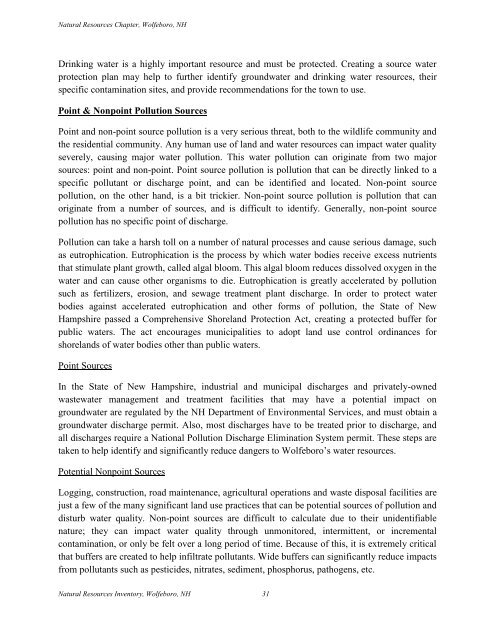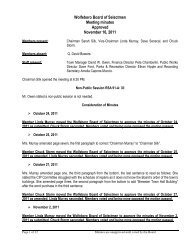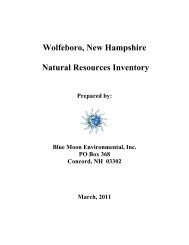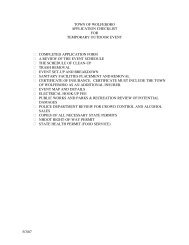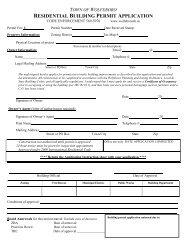Natural Resources Chapter of the Master Plan - Town of Wolfeboro
Natural Resources Chapter of the Master Plan - Town of Wolfeboro
Natural Resources Chapter of the Master Plan - Town of Wolfeboro
Create successful ePaper yourself
Turn your PDF publications into a flip-book with our unique Google optimized e-Paper software.
<strong>Natural</strong> <strong>Resources</strong> <strong>Chapter</strong>, <strong>Wolfeboro</strong>, NH<br />
Drinking water is a highly important resource and must be protected. Creating a source water<br />
protection plan may help to fur<strong>the</strong>r identify groundwater and drinking water resources, <strong>the</strong>ir<br />
specific contamination sites, and provide recommendations for <strong>the</strong> town to use.<br />
Point & Nonpoint Pollution Sources<br />
Point and non-point source pollution is a very serious threat, both to <strong>the</strong> wildlife community and<br />
<strong>the</strong> residential community. Any human use <strong>of</strong> land and water resources can impact water quality<br />
severely, causing major water pollution. This water pollution can originate from two major<br />
sources: point and non-point. Point source pollution is pollution that can be directly linked to a<br />
specific pollutant or discharge point, and can be identified and located. Non-point source<br />
pollution, on <strong>the</strong> o<strong>the</strong>r hand, is a bit trickier. Non-point source pollution is pollution that can<br />
originate from a number <strong>of</strong> sources, and is difficult to identify. Generally, non-point source<br />
pollution has no specific point <strong>of</strong> discharge.<br />
Pollution can take a harsh toll on a number <strong>of</strong> natural processes and cause serious damage, such<br />
as eutrophication. Eutrophication is <strong>the</strong> process by which water bodies receive excess nutrients<br />
that stimulate plant growth, called algal bloom. This algal bloom reduces dissolved oxygen in <strong>the</strong><br />
water and can cause o<strong>the</strong>r organisms to die. Eutrophication is greatly accelerated by pollution<br />
such as fertilizers, erosion, and sewage treatment plant discharge. In order to protect water<br />
bodies against accelerated eutrophication and o<strong>the</strong>r forms <strong>of</strong> pollution, <strong>the</strong> State <strong>of</strong> New<br />
Hampshire passed a Comprehensive Shoreland Protection Act, creating a protected buffer for<br />
public waters. The act encourages municipalities to adopt land use control ordinances for<br />
shorelands <strong>of</strong> water bodies o<strong>the</strong>r than public waters.<br />
Point Sources<br />
In <strong>the</strong> State <strong>of</strong> New Hampshire, industrial and municipal discharges and privately-owned<br />
wastewater management and treatment facilities that may have a potential impact on<br />
groundwater are regulated by <strong>the</strong> NH Department <strong>of</strong> Environmental Services, and must obtain a<br />
groundwater discharge permit. Also, most discharges have to be treated prior to discharge, and<br />
all discharges require a National Pollution Discharge Elimination System permit. These steps are<br />
taken to help identify and significantly reduce dangers to <strong>Wolfeboro</strong>‟s water resources.<br />
Potential Nonpoint Sources<br />
Logging, construction, road maintenance, agricultural operations and waste disposal facilities are<br />
just a few <strong>of</strong> <strong>the</strong> many significant land use practices that can be potential sources <strong>of</strong> pollution and<br />
disturb water quality. Non-point sources are difficult to calculate due to <strong>the</strong>ir unidentifiable<br />
nature; <strong>the</strong>y can impact water quality through unmonitored, intermittent, or incremental<br />
contamination, or only be felt over a long period <strong>of</strong> time. Because <strong>of</strong> this, it is extremely critical<br />
that buffers are created to help infiltrate pollutants. Wide buffers can significantly reduce impacts<br />
from pollutants such as pesticides, nitrates, sediment, phosphorus, pathogens, etc.<br />
<strong>Natural</strong> <strong>Resources</strong> Inventory, <strong>Wolfeboro</strong>, NH 31


